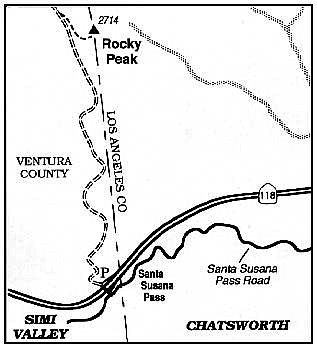 Facebook
Facebook
 X
X
 Instagram
Instagram
 TikTok
TikTok
 Youtube
Youtube
In 1990 the Santa Monica Mountains Conservancy (a state agency charged with acquiring land for parks in the Los Angeles area) entered negotiations with entertainer Bob Hope to purchase Rocky Peak Park -- a 4369-acre parcel of land overlooking the Simi and San Fernando Valleys. Today, the entire spread -- long locked up in private ownership and more recently threatened by creeping suburbia -- welcomes hikers and mountain bikers who can start their trip, conveniently enough, at the end of a freeway offramp.
A look at any topographic map of the park area reveals a loopy pattern of closely spaced contour lines, indicative of terrain topped by immense boulder piles. The sandstone that underlies this area dates from the Cretaceous period more than 65 million years ago. Relatively recent uplift, weathering, and erosion has carved this rock into impressively huge and intricate structures at the surface.
From the San Fernando Valley, take Freeway 118 west and exit at the Santa Susana Pass/Rocky Peak offramp. Park in the dirt lot on the right. Those approaching eastbound from Simi Valley and Ventura County will find there is no eastbound offramp here; instead, access to the trailhead is by way of Santa Susana Pass Road.
Ascent begins immediately on a dirt fire road ahead. At about 1.5 miles, the relentless climb is temporarily reversed by a brief drop into a little flat where, on the right, you can find shade and rest under a lone live-oak tree.
After passing larger and more impressively convoluted outcrops of sandstone, the fire road tops out on a prominent ridgeline, 2.4 miles up. There, an older, disused road (narrow enough to be a footpath now) joins on the right, leading circuitously toward Rocky Peak -- only a little higher but well worth another 0.4 mile of hiking for the sake of a fabulous view. The path soon becomes indistinct, and you face a somewhat scratchy scramble over a false summit, down, and back up to the highest pile of boulders.
The Rocky Peak summit defines a waypoint on the boundary between Los Angeles County and Ventura County. The view from the top at best encompasses large parts of these two counties, plus the Pacific Ocean -- partly obscured by the undulating Santa Monica Mountains.


In 1990 the Santa Monica Mountains Conservancy (a state agency charged with acquiring land for parks in the Los Angeles area) entered negotiations with entertainer Bob Hope to purchase Rocky Peak Park -- a 4369-acre parcel of land overlooking the Simi and San Fernando Valleys. Today, the entire spread -- long locked up in private ownership and more recently threatened by creeping suburbia -- welcomes hikers and mountain bikers who can start their trip, conveniently enough, at the end of a freeway offramp.
A look at any topographic map of the park area reveals a loopy pattern of closely spaced contour lines, indicative of terrain topped by immense boulder piles. The sandstone that underlies this area dates from the Cretaceous period more than 65 million years ago. Relatively recent uplift, weathering, and erosion has carved this rock into impressively huge and intricate structures at the surface.
From the San Fernando Valley, take Freeway 118 west and exit at the Santa Susana Pass/Rocky Peak offramp. Park in the dirt lot on the right. Those approaching eastbound from Simi Valley and Ventura County will find there is no eastbound offramp here; instead, access to the trailhead is by way of Santa Susana Pass Road.
Ascent begins immediately on a dirt fire road ahead. At about 1.5 miles, the relentless climb is temporarily reversed by a brief drop into a little flat where, on the right, you can find shade and rest under a lone live-oak tree.
After passing larger and more impressively convoluted outcrops of sandstone, the fire road tops out on a prominent ridgeline, 2.4 miles up. There, an older, disused road (narrow enough to be a footpath now) joins on the right, leading circuitously toward Rocky Peak -- only a little higher but well worth another 0.4 mile of hiking for the sake of a fabulous view. The path soon becomes indistinct, and you face a somewhat scratchy scramble over a false summit, down, and back up to the highest pile of boulders.
The Rocky Peak summit defines a waypoint on the boundary between Los Angeles County and Ventura County. The view from the top at best encompasses large parts of these two counties, plus the Pacific Ocean -- partly obscured by the undulating Santa Monica Mountains.
